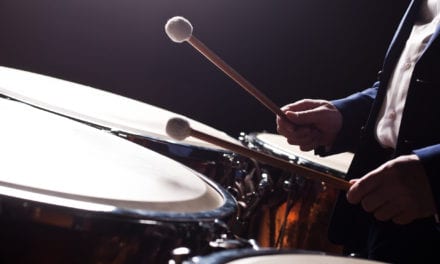By Cindy McTee
In recent years, conductors and performers of band music have shown unprecedented enthusiasm for the composition of new works. The result is a large body of substantive pieces written for an ensemble that promises even greater riches as we composers continue to mine the depth and breadth of the band’s unique sound.
The future of band music depends upon the kind of collaboration supported by Bands of America when it commissions new works for performance by young people. As a composer, educator, and former saxophonist, I am very grateful for the opportunity to participate in this process of growth and discovery, and anticipate an excellent première of my Ballet for Band by some of America’s best!
Ballet for Band (adapted from my Symphony No. 1: Ballet for Orchestra) was commissioned by The Revelli Foundation and its affiliate, Bands of America, for first performance by the BOA Honor Band of America this February 28 at the National Concert Band Festival, Eugene Migliaro Corporon, conductor.
Music is said to have come from dance — from the rhythmic impulses of men and women. Perhaps this explains my recent awareness of the inherent relationships between thought, emotion, and action – that the impulse to compose often begins as a rhythmical stirring and leads to a physical response – tensing muscles, gesturing with hands and arms, or quite literally, dancing.
In Music and the Mind, Anthony Storr observes that “the designation ‘movement’ for a section of a symphony, concerto, or sonata attests the indissoluble link between music and motion in our minds…” There is also much pleasure to be gained from observing the gestures of a conductor, or from seeing the coordinated bowing of the string sections within an orchestra.
Composer Roger Sessions writes eloquently on the subject as well in The Musical Experience of Composer, Performer, Listener: The basic ingredient of music is not so much sound as movement. I would even go a step farther, and say that music is significant for us as human beings principally because it embodies movement of a specifically human type that goes to the roots of our being and takes shape in the inner gestures which embody our deepest and most intimate responses.
My Ballet for Band emerged out of a similar kinesthetic/emotional awareness and a renewed interest in dance music. I first explored this approach to composition in a work entitled Circuits (1990) which reviewer Charles Ward described as follows: Circuits…was a charging, churning celebration of the musical and cultural energy of modern-day America.
Although I have never made a conscious attempt to create or reflect an “American” sound, I would agree that my musical style generally does reflect my American roots more than my European-based training. European writers, however, continue to shape my thinking, especially the Swiss psychologist, Carl G. Jung, who felt that creative energy sprang from the tension between the oppositions of conscious and unconscious, of thought and feeling, of objectivity and subjectivity, and of mind and body. So too have the integration and reconciliation of opposing elements become important aspects of my work. The frequent use of circular patterns, or ostinatos, offers both the possibility of suspended time and the opportunity for continuous forward movement.
Carefully controlled pitch systems and thematic manipulations provide a measure of objectivity and reason, while kinetic rhythmic structures inspire bodily motion. Discipline yields to improvisation, and perhaps most importantly, humor takes its place comfortably along side the grave and earnest. To quote Lord Byron: “On with the dance! Let joy be unconfined . . .”



